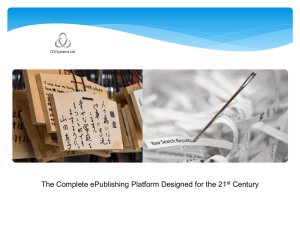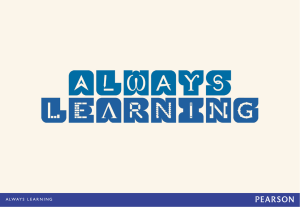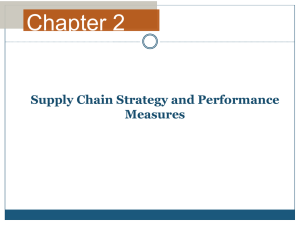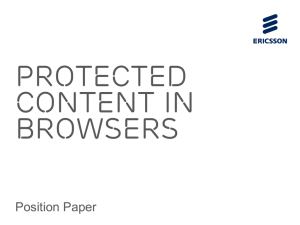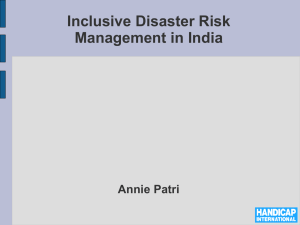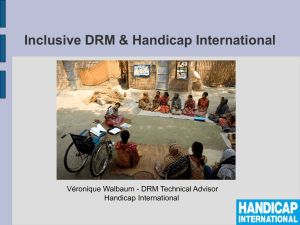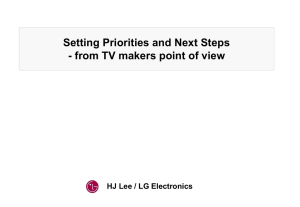jayeeta mullick_DRM_1
advertisement
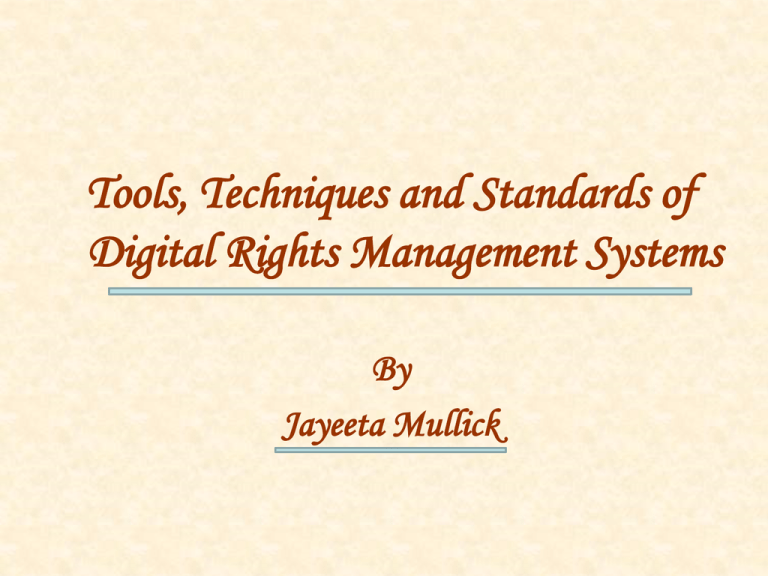
Tools, Techniques and Standards of Digital Rights Management Systems By Jayeeta Mullick Overview • • • • • • What is DRM? What are the Digital contents? Tools and Techniques of DRM DRM Standards Commercial DRM Systems DRM and its impacts in Libraries DRM Digital Rights Management (DRM) refers to those technologies which have been specifically developed for managing digital rights. “Digital rights management (DRM) is a class of access control technologies that are used by hardware manufacturers, publishers, copyright holders and individuals with the intent to limit the use of digital content and devices after sale. DRM is any technology that inhibits uses of digital content that are not desired or intended by the content provider.” –wikipedia. As stated in the eBook User Bill of Rights , “Digital Rights Management (DRM), like a tariff, acts as a mechanism to inhibit the free exchange of ideas, literature, and information.” What are Digital contents? Digital Materials are mostly digital files or programmes available in digital environment. Some of these are • • • • • • Documents/ E-text E-books/ E-Publishing Images Audio Video Software Theses digital contents are accessed through Computers, Phone, various types of video or audio players, TV etc. Tools and Techniques of DRM I. Encryption Encryption is a technique to protect digital work. In this technique file is encrypted using a key and only the key holders are able to decrypt the file. Sometimes when key is linked with BIOS or hardware of the authorized user then the security level will be increased. The key is the most important component in an encryption system. In this way unauthorized user access can be protected but not fully because key holders have the authority to disclose the key to other users. There are two possible scheme viz., private key (symmetric) cryptographic and public key (asymmetric) cryptography. A key is generally bound to a certificate that attests to the key’s validity. Keys are generally assigned by trusted third parties, who are responsible for certifying the security of keys, so that all parties trust the keys, and for assigning keys to specific users and uses. Tools and Techniques of DRM contd. Digital Certificate is a special kind of machine-readable document issued by a trusted Certificate Authority (CA) to an individual or organization which is unique to them. Some digital certificates conform to a standard, X.509. A Digital Signature is an electronic signature that can be used to authenticate the identity of a message sender or the signer of a document, and possibly to ensure that the original content of the message or document that has been sent is unchanged. A digital certificate contains the digital signature of the certificateissuing authority so that anyone can verify the authenticity. Tools and Techniques of DRM contd. II. Watermarking Watermarking is a group of methods and technologies that can be used to protect digital data. Watermarking may be used for copyright protection of Digital data. By watermarking techniques we can protect our files, images, audio, video, etc. Watermarking may also be used in authentication, certification, photo development laboratory, OCR software etc. Some watermarking tools available are WMT Plus, visual water mark etc. Tools and Techniques of DRM contd. III. Broadcast Flag The Broadcast Protection Discussion Group (BPDG) is a working group of content providers, television broadcasters, consumer electronics manufacturers, information technology companies, interested individuals. The group proposed that digital TV programs should be embedded with a "broadcast flag." A broadcast flag is a set of status bits (or a "flag") sent in the data stream of a digital television program that indicates whether the data stream can be recorded, or if there are any restrictions on recorded content. Tools and Techniques of DRM contd. IV. Licenses Licenses, sometimes also called end-user license agreements (EULAs), are a core component of DRM systems. Licenses documents and control permission are provided to the end users to access the protected content. Licenses may be hidden in encrypted content, such as water mark. A license usually communicates directly with a device to allow access to content. Many e-publishers, license DRM-enabled content for online transactions or subscription services. There are various types of models for distributors and consumers to choose from multiple fee/free business models. For example, the content could be included in both the free-content or it could be licensed on a fee-for pay use by different types of organizations viz. corporate, government or institutional users. Organisations need to update & incorporate new licensing requirements when necessary. Tools and Techniques of DRM contd. V. Secured hardware In recent years, hardware components with embedded DRM support and other security features have emerged to provide support for DRM controlled content. These include the SD memory card, TPM (Trusted Platform Module) microcontroller, SVP (Secure Video Processor). Tools and Techniques of DRM VI. contd. Secured Transmission Protocols Several protocols have been developed to secure the transport of protected content between devices across the networks. SSL (Secure Sockets Layers) or TLS (Transport Layer Security) are protocols for cryptographic communications over the internet. Secure Socket Layer version 3 (SSLv3) and its successor Transport Layer Security version 1 (TLSv1) are used to provide data integrity and security for network communications. These security protocols are used to secure application protocols such as HTTP, FTP, SIP, SMTP, NNTP, XMPP, and others. SSLv3/TLSv1 operates on a layer between the transport layer and the application layer. In this position it can support multiple application layer protocols by securing the application data before sending it to the transport layer. DRM Standards DRM technologies are cumbersome and can result many problems for consumers. Such as incompatibility with upgrades of operating systems, incompatible hardware upgrades, automatic upgrades from self-renewing DRM systems etc. DRM systems attempt to address these serious consumer concerns through DRM standards. It is “An end-to- end process for content delivery and consumption, specify standardized technologies for each step of the DRM process, and provide a certification process for content providers and device manufacturers to prove compliance with the standard.” DRM Standards… • SDMI (Secure Digital Music Initiative) SDMI was a forum formed in late 1998, composed of more than 200 IT, consumer electronics, security technology, ISP and recording industry companies, to develop technology specifications that protect the playing, storing, and distribution of digital music. But since 2001 technology is obsolete as team of researchers from Princeton and Rice universities successfully cracked the watermark with the four SDMI technologies. DRM Standards… • CPSA (Content Protection System Architecture) CPSA is a content technology protection framework that includes a number of technologies designed to protect content that is physically distributed through analog tapes or digital media. CPSA specifies technologies to protect content and to specify Content Management Information (CMI). Three basic objectives of CPSA's are: 1. to protect content at its source (wherever it is stored and whenever it is copied). 2. to protect content as it is transmitted (between transmission points or between devices). 3. to protect content from unauthorized copying. CPSA relies primarily on copy control information, watermarks and encryption. CPSA technology standards… There are a number of copy control technology standards that can be included under this CPSA category, some of them are mentioned here. CSS (Content Scramble System) is an encryption technology first introduced in 1996 and is licensed primarily for encrypting content stored on DVD. CSS utilizes a series of keys for encryption and decryption. CPPM (Content Protection for Pre-Recorded Media) utilizes a stronger encryption algorithm than CSS, key blocks, watermarking and revocation for compromised devices. CGMS (Copy Generation Management System) is information embedded in video signals, indicating whether the information can be copied, to prevent both initial and generational (copy of a copy) copying. CPRM is a renewable copy protection format for DVD- R/ RW and DVDRAM discs. Contd. CPSA technology standards… • VCPS (Video Content Protection System) provides copy- once protection for DVD-R and DVD-RW to enable direct digital recording of digital broadcasts from satellite and cable sources. • HDCP (High-bandwidth Digital Content Protection) a content protection system designed to protect illegal transmission of HighDefinition entertainment. It blocks unofficial digital interception and replication between a player and a monitor. HDCP protects the contents transmitted through cables using high definition interfaces, such as DVI (Digital Visual Interface) and UDI (Unified Display Interface). It protects transmission of content from a source device to a destination device, such as TV set-top, using authentification, encryption and key implementation. Contd. CPSA technology standards… • DTCP (Digital Transmission Content Protection) protects transmission over the cable and interface components between two communicating devices such as USB and fireware. It includes a device authentification and key exchange protocol. DTCP-IP extends DTCP to support transmission over IP networks, using 128 bit advanced encryption standard. DTCP are designed to incorporate with other DRM protocols. • Verance VCMS/AV Watermarking Technology protects DVD audio, HDDVD and Blu-ray audio content from being captured by either analog or digital recorders. • AACS (Advanced Access Content System) is a newer encryption standard for personal computing and consumer electronics devices that is intended to support high-definition content and to provide stronger protection for digital audiovisual content than the compromised CSS encryption technology provides. AACS uses 128-bit AES encryption, and a stronger key management system that involves media key block technology. Contd. CPSA technology standards… • BD+ is an additional layer of content protection developed for Blu-ray discs. It is defined as a ‘virtual machine-based content protection technology’. • MPEG IPMP-X. The Moving Picture Experts Group (MPEG) is responsible for a range of standards to encode and manage digital video and audio. IPMP-X (Intellectual Property Management and Protection Extension) is a DRM architecture based on principles of normative re-use of standard DRM technologies; mutual authentication to create an authenticated channel for secure communications CPSA technology standards… • OMA DRM is a digital rights management system that emerged from the Open Mobile Alliance, a consortium of mobile system manufacturers, mobile phone manufacturers, mobile telecom providers and IT companies. • CMLA (Content Management Licensing Administrator) is an created by four companies - Intel, Nokia, Panasonic and Samsung - to implement a “trust model” for the Open Mobile Alliance (OMA) Digital Rights Management technical specification version 2.0 standards. Commercial DRM Systems In addition to open standards that might be utilized by a range of commercial and non-commercial entities, there are many proprietary DRM systems • DRM technology has been embraced by many of the largest companies in the world including Apple, Microsoft, Disney, Sony, IBM and Intel. • Windows Media DRM (WM-DRM) is an end-to-end DRM system that can be applied by anyone in a Windows environment to provide secure delivery of digital media over an IP network. • Adobe Acrobat has the facility to protect digital work from copying and pasting. Adobe has incorporated DRM into its digital creation applications, such as Adobe Acrobat Professional, which supports assigning digital signatures to verify a file's authenticity, file encryption, password protection for files, and role-based permissions for file access and use. • Apple FairPlay is a DRM system integrated with QuickTime multimedia technology that provides DRM for protected digital files for the iPod, iTunes and iTunes Music Store applications. DRM and Libraries In the increasingly protected digital information space, libraries may be supplying digital content which is controlled by DRM technologies that the library may not manage. Security of digital data and DRM is essential because through this a large amounts of new content can be made available in safe, open, and trusted environments. DRM and Libraries….. Contd. • By embedding controls within the product, providers can prevent the public from use that is non-infringing under copyright law as well as enforce restrictions that extend far beyond those specific rights enumerated in the Copyright Act (or other laws). Thus, DRM changes the fundamental relationship between the creators, publishers, and users, to the detriment of creators, users, and the institutions that serve them. DRM and Libraries….. Contd. But there are significant challenges as well, especially in these areas: • Archiving and Future Use Libraries subscribing online databases, the content and the control of the content will remain in vendor systems, and libraries are just "outsource" access to the digital materials. Some titles are available on a term-limited licensing basis, many titles are being offered for sale to libraries on a perpetual basis , but it doesn’t mean that libraries are physically acquiring the digital files. There is also no guarantee of future access and the addition of DRM into this can make it more worse. DRM and Libraries….. Contd. • Infrastructural upgrade: access and control Libraries and archives that deal with electronic formats have long been concerned about the problem of format obsolescence, information could be inaccessible or it cannot be read by modern hardware. while using these e-documents we have to go through a complex system to open and read a book, So, its a big question what happens twenty or fifty or a hundred years from now when that system no longer exist? Diversity in e-book formats Different e-book publishers publish their books in different formats. Like, Amazon Kindle (published as: .azw; .kf8); Apple iBooks Author(.iba); Broadband eBooks ( .lrf; .lrx); Comic Book Archive file (.cbr , .cbz , .cbt , .cba); eReader (.pdb); Hypertext Markup Language (.htm; .html); Microsoft Reader (.lit); Mobipocket (.prc; .mobi); Multimedia eBooks (.exe or .html); Open Electronic Package (.opf); Portable Document Format (.pdf) and many more. So, in such a scenario Hardware, software and OS compatibility are very important aspects for managing these data in libraries. conclusion • There is no doubt that DRM has the potential to have a tremendous impact on libraries and how they do their work. Exactly what the impact will be, is hard to predict today because, this is a technology in the early stages of its potential development. • But it is possible to present some general cautions based on current experience with protected works. Thank You
